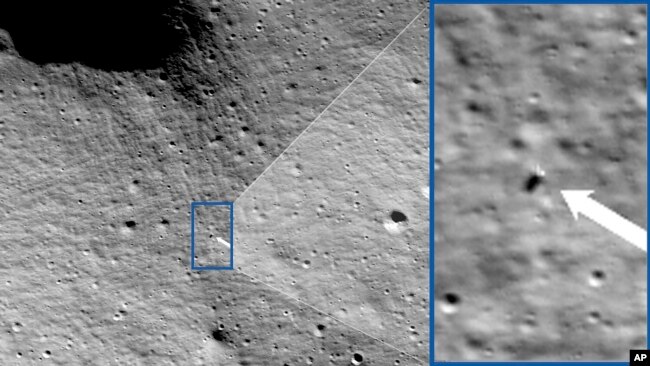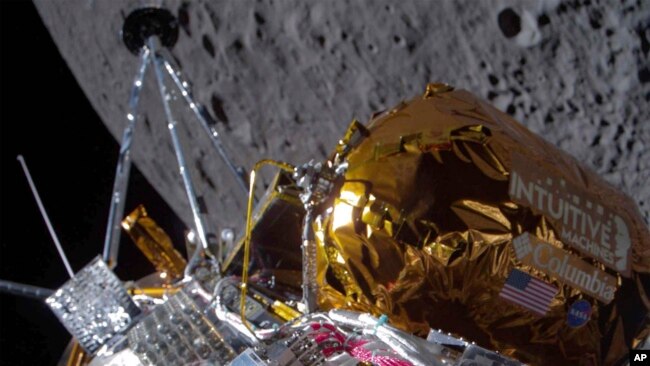미국의 민간 달 착륙선이 화요일 작동을 중단합니다
Private US Lunar Lander Will Stop Working Tuesday
페이지 정보
작성자 By Associated Press 작성일 24-02-26 13:22 댓글 0본문

NASA가 제공한 이 사진들은 오디세우스가 착륙을 완료한 것을 확인한 NASA의 달 정찰 궤도 카메라 팀의 이미지를 보여줍니다. (NASA/Goddard/Arizona State University by AP)
These photos provided by NASA show images from NASA’s Lunar Reconnaissance Orbiter Camera team which confirmed Odysseus completed its landing. (NASA/Goddard/Arizona State University via AP)
케이프 커내버럴, 플로리다 주
CAPE CANAVERAL, Fla. —
미국의 민간 달 착륙선이 화요일에 작업을 중단할 것으로 예상되는데, 달의 남극 부근에 옆으로 착륙한 후 임무가 중단되었습니다.
A private U.S. lunar lander is expected to stop working Tuesday, its mission cut short after landing sideways near the south pole of the moon.
이 우주선을 만들고 비행시킨 휴스턴의 회사인 인튜이티브 머신스는 월요일, 햇빛이 더 이상 태양 전지판을 비추지 않을 때까지 데이터를 계속 수집할 것이라고 말했습니다. 지구와 달의 위치에 기초하여, 관계자들은 화요일 아침에 이런 일이 일어날 것으로 예상하고 있습니다. 이는 NASA와 다른 고객들이 기대했던 한 주의 약 2-3일이 부족한 것입니다.
Intuitive Machines, the Houston company that built and flew the spacecraft, said Monday it will continue to collect data until sunlight no longer shines on the solar panels. Based on the position of Earth and the moon, officials expect that to happen Tuesday morning. That's two to three days short of the week or so that NASA and other customers had been counting on.
오디세우스(Odysseus)라는 이름의 이 착륙선은 50여 년 만에 처음으로 달에 착륙한 미국 우주선으로, 주요 후원사인 나사(NASA)의 실험을 실었습니다. 하지만 회사 관계자에 따르면 지난 목요일 너무 빨리 착륙해 여섯 다리 중 한 다리의 발이 표면에 걸려 넘어졌습니다.
The lander, named Odysseus, is the first U.S. spacecraft to land on the moon in more than 50 years, carrying experiments for NASA, the main sponsor. But it came in too fast last Thursday and the foot of one of its six legs caught on the surface, causing it to tumble over, according to company officials.
미국 항공우주국(NASA)의 달 정찰 궤도선이 머리 위를 날고 있는 사진을 바탕으로 오디세우스는 달의 남극에서 불과 300km 떨어진 말라퍼트 A 분화구 근처에 의도된 목표물의 1.5km 이내에 착륙했습니다.
Based on photos from NASA's Lunar Reconnaissance Orbiter flying overhead, Odysseus landed within 1.5 kilometers of its intended target near the Malapert A crater, just 300 kilometers from the moon's south pole.

Intuitive Machine에서 제공한 이 이미지는 2024년 2월 21일 달 궤도 삽입 후 달의 가까운 면에 Odysseus 달 착륙선을 보여줍니다. 착륙선은 2월 22일 표면으로 스스로 안내했습니다. (AP를 통한 직관적인 기계)
This image provided by Intuitive Machines shows its Odysseus lunar lander over the near side of the moon following lunar orbit insertion, Feb. 21, 2024. The lander guided itself to the surface Feb. 22. (Intuitive Machines via AP)
90킬로미터 상공에서 찍은 LRO 사진은 착륙선을 표면에 보여주는 유일한 사진이지만, 알갱이 같은 이미지 속의 한 점에 지나지 않습니다. 착륙선이 하강할 때의 이미지를 포착하기 위한 Embry-Riddle 항공 대학의 카메라 발사 실험은 막판 탐색 문제로 인해 터치다운 직전에 취소되었습니다.
The LRO photos from 90 kilometers up are the only ones showing the lander on the surface, but as little more than a spot in the grainy images. A camera-ejecting experiment by Embry-Riddle Aeronautical University, to capture images of the lander as they both descended, was called off shortly before touchdown because of a last-minute navigation issue.
NASA에 따르면, 그 착륙선은 12도 경사를 가진 작고 황폐한 분화구에 도착했습니다. 그것은 우주선이 남극에 온 것 중 가장 가까운 것인데, 그곳은 영구적으로 그림자가 드리워진 분화구에 있는 얼어붙은 물로 의심되기 때문에 관심이 있는 지역입니다.
According to NASA, the lander ended up in a small, degraded crater with a 12-degree slope. That's the closest a spacecraft has ever come to the south pole, an area of interest because of suspected frozen water in the permanently shadowed craters there.
향후 몇 년 안에 이 지역에 우주 비행사를 착륙시킬 계획인 나사는 인튜이티브 머신즈에 6개의 실험을 제공하기 위해 1억 1,800만 달러를 지불했습니다. 다른 고객들도 기내에 물건을 가지고 있었습니다.
NASA, which plans to land astronauts in this region in the next few years, paid Intuitive Machines $118 million to deliver six experiments to the surface. Other customers also had items on board.
4.3미터 높이의 오디세우스는 똑바로 착륙하지 않고 옆으로 내려와 지구와의 교신을 방해했습니다. 일부 안테나는 착륙선이 덮었고, 일부 안테나는 여전히 노출된 안테나가 땅 근처에 이르러 얼룩덜룩한 통신을 했습니다. 또한 태양 전지판은 예상보다 훨씬 더 지표면에 가까이 다가갔고, 구릉지에서는 이상적이지 못했습니다. 상황이 아무리 좋아도 오디세우스는 긴 달밤이 시작되기 전에 겨우 일주일 동안 지표면에서 활동할 수 있었습니다.
Instead of landing upright, the 4.3-meter Odysseus came down on its side, hampering communication with Earth. Some antennas were covered up by the toppled lander, and the ones still exposed ended up near the ground, resulting in spotty communications. The solar panels also ended up much closer to the surface than anticipated, less than ideal in the hilly terrain. Even under the best of circumstances, Odysseus only had a week to operate on the surface before the long lunar night set in.
1960년대 이후 달 착륙에 성공한 나라는 미국, 러시아, 중국, 인도, 일본뿐이었고, 승무원이 있는 나라는 미국뿐이었습니다. 일본의 착륙선은 지난 달에도 결국 잘못된 방향으로 가게 된 것입니다.
Since the 1960s, only the U.S., Russia, China, India and Japan have successfully pulled off moon landings, and only the U.S. with crews. Japan's lander ended up on the wrong side, too, just last month.
기울어진 착륙에도 불구하고, Intuitive Machines는 이 엘리트 그룹에 합류한 첫 번째 민간 기업이 되었습니다. 또 다른 미국 회사인 Astrobotic Technology는 지난 달 그것을 시도했지만 연료 누출 때문에 달에 가지 못했습니다.
Despite its slanted landing, Intuitive Machines became the first private business to join the elite group. Another U.S. company, Astrobotic Technology, gave it a try last month, but didn't make it to the moon because of a fuel leak.
직관적인 기계들도 거의 실패할 뻔 했습니다. 지상 팀들은 플로리다로부터의 2월 15일 발사 전에 착륙선의 항법 레이저의 스위치를 켜지 않았습니다. 오디세우스가 달 주위를 돌 때까지 그 감시는 발견되지 않았고, 비행 조종사들은 단지 실험을 위해 탑승했던 NASA 레이저 항법 장치에 의존하도록 강요했습니다.
Intuitive Machines almost failed, too. Ground teams did not turn on the switch for the lander's navigating lasers before the Feb. 15 liftoff from Florida. The oversight was not discovered until Odysseus was circling the moon, forcing flight controllers to rely on a NASA laser-navigating device that was on board merely as an experiment.
밝혀진 바와 같이, 나사의 테스트 레이저는 오디세우스를 황소의 눈에 가까운 착륙으로 안내했고, 그 결과 아폴로 계획 이후 처음으로 미국 우주선에 의한 달 착륙이 이루어졌습니다.
As it turned out, NASA's test lasers guided Odysseus to a close to bull's-eye landing, resulting in the first moon landing by a U.S. spacecraft since the Apollo program.
1969년부터 1972년까지 12명의 아폴로 우주비행사들이 달 위를 걸었습니다. 나사가 가끔 달 주위에 위성을 설치하는 동안, 미국은 지난 달까지 또 다른 달 착륙 임무를 시작하지 않았습니다. 아스트로보틱의 실패한 비행은 달로의 상업적 배달을 촉진하는 나사의 프로그램에 따라 이루어진 첫 번째 비행이었습니다.
Twelve Apollo astronauts walked on the moon from 1969 through 1972. While NASA went on to put an occasional satellite around the moon, the U.S. did not launch another moon-landing mission until last month. Astrobotic's failed flight was the first under NASA's program to promote commercial deliveries to the moon.
Intuitive Machines와 Astrobotic 둘 다 NASA와 더 많은 달 착륙 계약을 맺고 있습니다.
Both Intuitive Machines and Astrobotic hold NASA contracts for more moon landings.
출처 : VOANews
댓글목록 0
등록된 댓글이 없습니다.

















